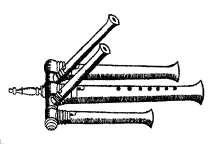
Athanasius Kircher's amazing musical encyclopaedia Musurgia Universalis of 1650 (Lib VI pp.505-6) has a picture of an instrument due to D. Manfredus Septalius which combines one ordinary recorder with fingerholes with four higher-pitched ones without - they seem to be mounted in a rotating sleeve, switching the airflow in and out by rotating them in and out of parallel with the "chanter" to make a flute-family analogue to the Northumbrian bagpipe. (Or perhaps the pipes were rotated at the top along their own long axis to switch the airflow; the principle of the mechanism seems to have been a trade secret). Unlike any bagpipe, the "drones" were higher pitched than the "chanter".
Kircher's description in the original Latin:
Misit non ita pridem ad me Praenob. ac ingeniosissimus Vir D. Manfredus Septalius amicus sincerissimus aliud exoticum instrumentum fistulare, cuius iconem hic exhibemus; constat 5 fistulis quorum 3 ABC axi FG insertae, reliquae duae DE intra axem videntur circumagi, quis tamen proprie eius usus sit comperire non licuit.
My translation:
Thus, not long ago, a very noble and most ingenious man and most sincere friend, Mr Manfred Maurer, sent me another exotic pipe, whose picture we show here; it comprises 5 pipes of which three (A, B, C) are inserted in the axis FG, and the remaining two DE can be seen rotated on the axis, although it is not permitted to describe their specific function.
(There are no letters on the original diagram, but it's obvious what he means).
If you encounter a physical example of anything like that, or make one that works, I'd like to hear from you.
It seems to me that it would make more sense to use closed pipes for the drones, like a swannee whistle, so they could play an octave lower for the same length, but Kircher's picture clearly shows open ends, and his diagrams are always very precise. Assuming a C descant recorder and that it's all to scale, the drones would be D, E, G, and A, which is a sensible selection.
Added later: Nicholas Lander (maintainer of the world's best recorder website) followed up my Usenet query about this instrument as follows:
An identical instrument may be found in the Museo Civico, Bologna, comprising a recorder four drone pipes joined by a common tube and blown through a mouthpiece. It is said to have been invented by Manfredo Settala. There is a vanitas painting by Evaristo Baschenis that includes both a flauto harmonico and a portrait -- possibly of Settala as a clown. A copy has been made by Rainer Weber.For more information, see the following references:
Puglisi, F. (1981). Signor Settala's 'armonia di flauti.' Early Music 9(3): 320-324.
Weber, R. (1992). Der Flauto Harmonico -- ein seltenes Instrument und sein Erbauer. Tibia 17(1): 20-26.